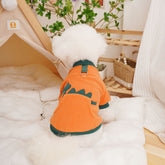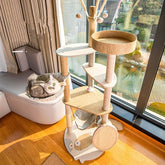Gardenias and Cats: The Essential Guide for Pet Owners
Table of Contents
- Key Highlights:
- Introduction
- The Beauty of Gardenias
- Understanding Plant Toxicity
- Potential Symptoms of Ingestion
- Common Misconceptions About Plant Safety
- Creating a Pet-Friendly Garden
- Vet Q&A: Common Concerns About Gardenias
- Expert Insights
- Smart Pet Parent Tip 🐾
- Expanding Your Knowledge: Other Safe Plants for Cats
- Final Thoughts on Plant Safety for Cats
- FAQ
Key Highlights:
- Gardenias are non-toxic to cats, making them a safe addition to homes with feline companions.
- Mild gastrointestinal upset may occur if cats ingest gardenia leaves, but serious health issues are rare.
- Understanding which plants are safe for pets can alleviate anxiety for pet owners while enhancing home aesthetics.
Introduction
As a pet owner, the safety of your furry friend is always a top priority, particularly when it comes to the plants in your home and garden. A common concern among cat owners is whether certain plants pose a risk to their pets. Gardenias, with their lush foliage and fragrant blooms, are often a popular choice for indoor and outdoor spaces, but how safe are they for cats? This article delves into the characteristics of gardenias, their effects on cats, and essential tips for ensuring a harmonious environment between pets and plants.
The Beauty of Gardenias
Gardenias (Gardenia jasminoides) are renowned for their striking white flowers and glossy green leaves. These evergreen shrubs thrive in warm climates, and their fragrant blooms are often associated with southern gardens and romantic settings. Beyond their visual appeal, gardenias have a long history in traditional medicine and are valued for their essential oils. For pet owners, the question of safety arises: can these beautiful plants coexist with our feline friends?
Understanding Plant Toxicity
One of the primary concerns for pet owners is the potential toxicity of plants. While some plants can be harmful or even fatal to pets, gardenias are classified as non-toxic to cats. The American Society for the Prevention of Cruelty to Animals (ASPCA) lists gardenias as safe for felines, which provides a level of reassurance for cat owners looking to enhance their indoor or outdoor spaces with these lovely plants.
Potential Symptoms of Ingestion
While gardenias are safe, it’s essential to monitor your cat's interaction with them. If a cat ingests a small amount of gardenia leaves or flowers, they may experience mild gastrointestinal upset. Symptoms can include:
- Vomiting
- Diarrhea
These symptoms are typically self-limiting and resolve without the need for medical intervention. However, if a cat shows persistent or severe symptoms, it’s advisable to consult a veterinarian for further evaluation.
Common Misconceptions About Plant Safety
A prevalent misconception among pet owners is that all plants are inherently toxic to cats. This notion can lead to unnecessary anxiety and the exclusion of beautiful flora from homes. In reality, many plants, including gardenias, are safe and can coexist with pets. Understanding which plants are non-toxic is crucial for creating a pet-friendly environment without sacrificing aesthetics.
Creating a Pet-Friendly Garden
When designing a garden or selecting houseplants, pet owners should consider the safety of their feline companions. Here are some pet-friendly options that can complement gardenias in your home:
- Spider Plant (Chlorophytum comosum): Known for its air-purifying qualities, this plant is non-toxic to cats and safe to have around.
- Bamboo Palm (Chamaedorea seifrizii): This attractive palm is not only safe for pets but also helps improve indoor air quality.
- Boston Fern (Nephrolepis exaltata): A lush, feathery fern that is non-toxic and adds a touch of greenery to your space.
By opting for these and other pet-safe plants, you can create a beautiful and secure environment for both your plants and your pets.
Vet Q&A: Common Concerns About Gardenias
Can cats safely eat gardenia flowers?
While it is generally safe for cats to be around gardenia plants, it’s best to prevent them from ingesting the flowers or leaves due to the possibility of mild gastrointestinal upset.
Is it okay for cats to sniff or rub against gardenia plants?
Cats can safely interact with gardenia plants by sniffing or rubbing against them. The appealing fragrance of gardenia blooms may attract your feline friend, but it's important to keep an eye on their behavior to prevent any accidental ingestion.
What should I do if my cat eats a large amount of gardenia leaves?
If your cat ingests a significant amount of gardenia leaves or exhibits signs of severe distress, such as prolonged vomiting or diarrhea, immediate veterinary care is recommended to ensure their safety and well-being.
When should I call the vet?
Pet owners should seek veterinary advice if they notice any of the following symptoms:
- Persistent vomiting or diarrhea
- Lethargy or weakness
- Difficulty breathing
- Loss of appetite
Expert Insights
Veterinarians emphasize the importance of being informed about plant safety for pets. Dr. Samantha H., a feline specialist, reassures pet owners, stating, "Gardenias are generally safe for cats, but it's always best to monitor your pet for any signs of distress if they come into contact with the plant."
Dr. Javier M., a veterinary botanist, adds, “As a veterinarian with a background in botany, I can confidently say that gardenias pose minimal risk to cats when consumed in small quantities.”
Smart Pet Parent Tip 🐾
To ensure the safety of your curious cat, consider keeping your gardenia plants out of their reach. This simple precaution can help prevent any accidental ingestion and provide peace of mind for pet owners.
Expanding Your Knowledge: Other Safe Plants for Cats
Beyond gardenias, there are numerous plants that are safe for cats. Here are a few additional options that pet owners can consider incorporating into their homes:
1. African Violet (Saintpaulia)
These charming flowering plants are a favorite among indoor gardeners. African violets are non-toxic to cats and can add vibrant colors to your home.
2. Areca Palm (Dypsis lutescens)
Also known as the butterfly palm, this plant is safe for pets and offers a tropical aesthetic that brightens indoor spaces.
3. Calathea (Calathea spp.)
With its stunningly patterned leaves, calathea is non-toxic to cats and serves as a striking decorative piece in any room.
4. Parlor Palm (Chamaedorea elegans)
This low-maintenance palm is excellent for pet owners; it’s safe for cats and thrives in low-light conditions.
5. Pepperomia (Pepperomia spp.)
This diverse genus offers numerous varieties that are both attractive and safe for cats, making it an ideal choice for plant lovers.
Final Thoughts on Plant Safety for Cats
Creating a pet-friendly environment does not mean sacrificing beauty or style in your home. By selecting plants that are safe for cats, such as gardenias and others mentioned above, pet owners can enjoy the tranquility and aesthetics of indoor greenery without worrying about their pets' safety. Understanding the common misconceptions surrounding plant toxicity is essential in fostering a harmonious relationship between pets and plants.
As you cultivate your living space, consider your pet’s safety and well-being, and don’t hesitate to reach out to your veterinarian for guidance on plant choices. With the right knowledge, you can create a lush, beautiful environment that both you and your feline companions can enjoy.
FAQ
Are gardenias safe for other pets, like dogs?
Yes, gardenias are generally considered non-toxic for both cats and dogs, making them a safe choice for households with multiple types of pets.
How can I tell if my cat has ingested something harmful?
Signs of ingestion can include vomiting, diarrhea, lethargy, or unusual behavior. If you suspect your cat has ingested something harmful, consult your veterinarian immediately.
Can gardenias cause allergic reactions in cats?
While allergies to gardenias in cats are rare, individual sensitivities can occur. If your cat exhibits unusual symptoms after exposure, consult your veterinarian for advice.
What should I do with my gardenias during winter?
If you live in colder climates, consider bringing your gardenias indoors during winter months or providing them with adequate protection outdoors to ensure their survival.
Do gardenias require special care?
Gardenias thrive in well-drained soil and prefer humid conditions. Regular watering and occasional feeding with a balanced fertilizer can help maintain their health and beauty.





